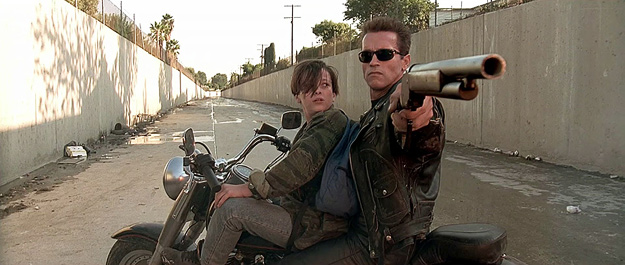“I was sick at the time. I had a high fever.” Cameron recalled. “I was just lying on the bed thinking and came up with all this bizarre imagery... I think also the idea that because I was in a foreign city by myself and I felt very dissociated from humanity in general, it was very easy to project myself into these two characters from the future who were out of sync, out of time, out of place.”
That helped the writer in Cameron to create two unique characters, the robot Terminator and the human soldier, Reese. Their differences made them interesting beyond the typical action flick. Add a vulnerable but believable heroine in Sarah Connor and you have a movie that has aged well.
The vision was so vivid that Cameron even imagined how the robot moved and made it part of the film. “What I found effective on Terminator was to do a slow-motion build-up, or to subtly segway into slow-motion where you almost don’t realize it, and it becomes a dreamlike pace or that dilation of time that you experience when you’re in a traffic accident and it’s happening and you can’t stop it and time seems to stretch,” he said.

Check out the scene in the nightclub when the three main characters meet: the Terminator (Arnold Schwarzenegger) tries to kill Sarah Connor (Linda Hamilton) but is stopped by Kyle Reese (Michael Biehn).
The threat of nuclear war was on people’s minds in the early 1980s. Cameron used the form of robots to deal with the subject of war. The first movie turned out to be realistic looking not only because of its low budget but also because it kept things grounded in a real world. The T-800 looked and seemed real compared to the fascinating but more advanced robots to follow. The tech noir visuals were also instrumental in creating a world we lived in at the time.
The ending of the first movie stayed true to its realistic story with Reese sacrificing himself to save Sarah, who in turn, finds the courage to terminate the robot when it refuses to stop trying to kill her. There was a hopeful yet ambiguous ending to the story.
What started as a vision in the Canadian filmmaker’s head is now part of the Library of Congress for preservation in the American National Film Registry as “culturally, historically or aesthetically significant.” No one, not even Cameron, could have foreseen that future back in 1983 when the film was being shot in Los Angeles.

By the time Terminator 2: Judgment Day came out in 1991, the world was a little different. The Berlin Wall had come down. There seemed to be more hope. The second movie showed the best relationship between boy and machine, a Terminator that becomes a father figure. On the flip side, Cameron made its heroine into more like the machine she’s trying to stop. That included a liquid type of Terminator that could imitate humans. How apropos.
At the end of T2, the war has stopped and there is hope for the future. By the time Terminator 3: Rise of the Machines was released in 2003, so much had changed in our society. Fear had taken a stranglehold, especially after the events of 9/11. Despite the best efforts by John Connor, Kate Brewster and the good Terminator, Judgment Day occurs anyway, ending the third movie on a downbeat note which reflects the mood early in the new century.

Six years later, there were plenty of unknowns, including the worst recession in seven decades, high unemployment, and a never ending war in the Middle East. So Terminator Salvation seemed stuck in a future that may or may not happen and an open-ended resolution where one big victory doesn’t mean much in the endless war against the machines. At least John Connor is active and becoming the leader spoken of in the very first movie – even if he needed the heart of a hybrid man/machine to live another day…

…only to become the villain in the new Terminator Genisys. It may have been a neat twist to the franchise but Linda Hamilton’s transformation from scared waitress to tough robotic hunter in the first two films was much more interesting.
The fifth film in the series turns and twists all over the previous timelines. We live in confusing times, so perhaps the story had to become just as convoluted? Or were the filmmakers being ironic when Schwarzenegger said “I’m old, not obsolete?”
The ending of Terminator Genisys may reflect society’s hope today that things will get better… that “the future is not set. There is no fate but what we make for ourselves.”
- Mario Boucher

